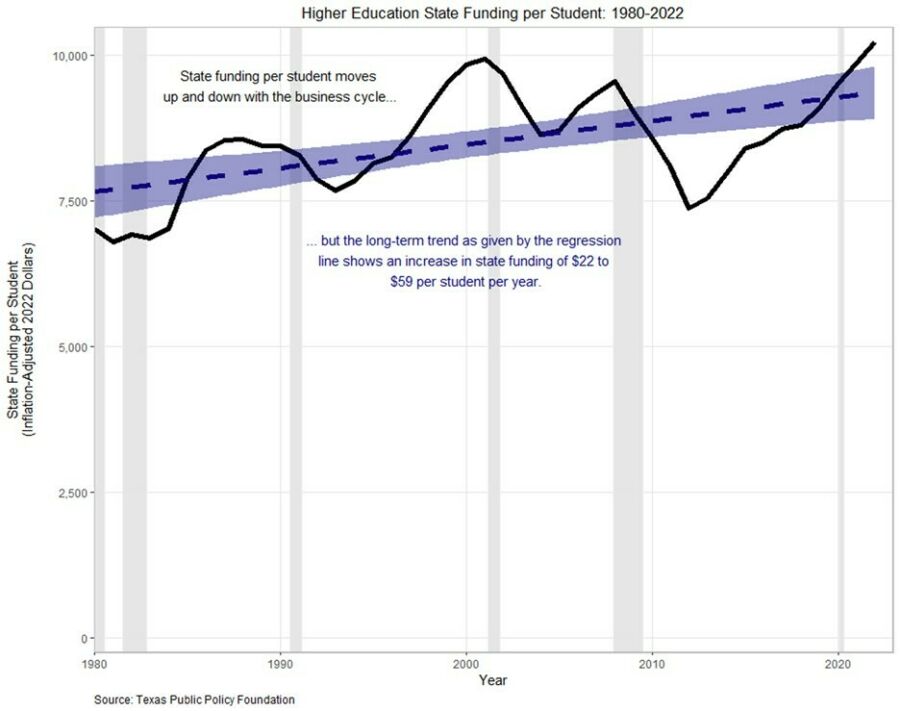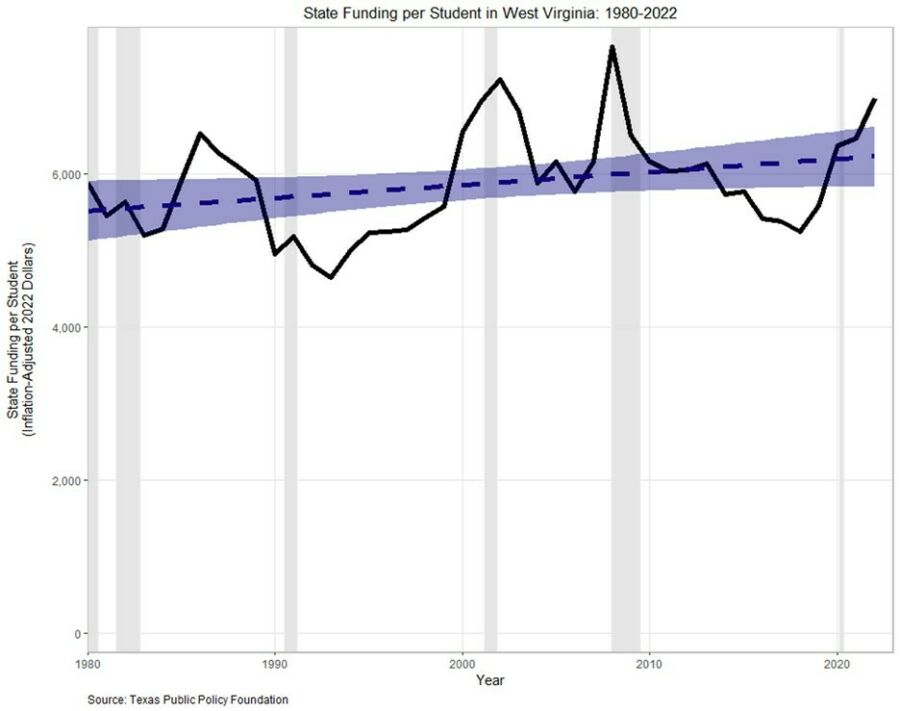One of the key stories in higher education finance is so-called “state disinvestment,” which alleges that states have made relentless cuts to college and university funding. But state disinvestment is a myth—states have not, in fact, disinvested in higher education. In this debate, a picture is worth a thousand words, so here is a figure (copied from a new report) showing per-student state funding for higher education over the past forty-two years, adjusted for inflation:

Disinvestment implies a downward slope, yet the slope of the line is clearly upward, meaning that states have actually increased funding for colleges and universities over time (by $22 to $59 per student per year). In fact, in 2022 (the most recent year with data), state funding was the highest ever recorded. Needless to say, setting funding records is inconsistent with a story of decades-long state disinvestment.
The evidence debunking state disinvestment isn’t new (see here and here), and yet the myth persists. In fact, it is rare that a week goes by where I don’t read about state disinvestment stated as fact. For example, Neal Hutchens and Frank Fernandez, professors of educational policy studies and evaluation and higher education administration and policy, respectively, recently wrote, “there has been a sustained longer-term trend of lower funding from states for their public colleges and universities.” Similarly, Kevin R. McClure and Barrett J. Taylor, professors of higher education, advocate “doing what it takes to secure the revenue needed to make up for state funding cuts.”
I highlight these scholars because their specialty is higher education or education policy, so the fact that they don’t recognize that state funding is trending up rather than down is bizarre. It would be like an economist arguing that we’ve recently been suffering from deflation rather than inflation.
The widespread belief in the state disinvestment myth is severely distorting public policy as well. For example, West Virginia University is cutting back, which includes laying off some tenured faculty. Liam Knox reports:
Neither Gee nor Reed placed much emphasis on the role of state disinvestment in creating WVU’s budget problems, an omission that [Kelly Allen, executive director of the nonprofit West Virginia Center on Budget and Policy] said was curious. West Virginia’s state funding for higher education has decreased by over 25 percent in the past decade, according to a Center for Budget and Policy study.
“They are truly selling state disinvestment short; that’s the primary reason for these budget shortfalls, not these universal problems,” Allen said.
But is West Virginia guilty of state disinvestment? No. Here’s per-student state funding in West Virginia since 1980:

The trend line is slightly up, not down, which means that state disinvestment is a myth for West Virginia, too. There is simply no truth to Allen’s claim that the real cause of the cuts at WVU is state disinvestment. The state has not been disinvesting, and even if WVU’s allocation is lower, the issue would be the reallocation of funding among colleges and universities rather than disinvestment.
There are a few reasons why so many otherwise smart people are making such a basic mistake.
First, there’s confirmation bias. Because it is impossible to read much about higher education finance without seeing state disinvestment stated as fact by otherwise reputable people, most will simply adopt “state disinvestment is true” as the conventional wisdom, requiring little if any supporting evidence.
Second, there are, indeed, times when states do cut funding, usually around recessions. By cherry-picking the comparison dates, one can almost always find a time period that shows a decline, which seems to confirm state disinvestment. For example, even though four decades of data show no state disinvestment in West Virginia, funding really is lower in 2022 than it was in 2008. But the problem with cherry-picking is that it doesn’t yield reliable results—it selectively chooses evidence that supports a predetermined conclusion, rather than considering all the available evidence to draw more accurate conclusions.
Third, many fail to adjust for inflation. Any comparison of the value of a dollar today to a dollar four decades ago hinges on adjusting for inflation correctly. Unfortunately, an influential report from the State Higher Education Executive Officers (SHEEO) association does not adjust for inflation. Rather than following established standards and using a legitimate price index, SHEEO uses a custom-made one called the Higher Education Cost Adjustment (HECA), which adjusts for estimated costs. Yet the HECA severely overstates inflation. As I noted in a new report,
The HECA adjustment thus overestimates state funding in 1980 by over 36%, more than $2,500. By massively overstating past funding, HECA is heavily biased toward finding state disinvestment. This bias is so strong that even if state funding increased by $2,500 per student, the HECA adjustment would falsely record that as a decline.
Here’s the bottom line: while higher education is suffering from many problems, state disinvestment isn’t one of them. It’s time to leave this myth in the dustbin of history.